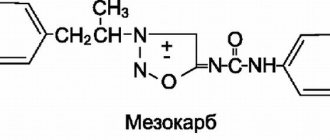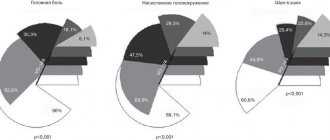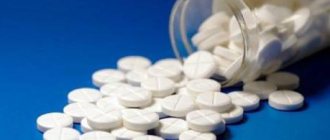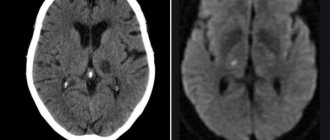N. B. Zharkova, G. I. Kopeiko, A. A. Mukhin NCPZ RAMS, Moscow
Psychiatry and psychopharmacotherapy :: N1/1999
Clopixol (zuclopenthixol), which has rightfully become a classic first-line antipsychotic for foreign specialists, is one of the newest and least studied drugs for most domestic psychiatrists. At the same time, there is great interest in both the peculiar spectrum of psychotropic activity of Clopixol, which combines a pronounced antipsychotic effect with a transient sedative and specific inhibitory effect, and the existence of various dosage forms of the drug, among which, along with the already familiar tablets and depot injections, there is a unique one that does not have analogues injectable form with a three-day effect (Clopixol-Acufaz).
Zuclopenthixol is a powerful antipsychotic drug from the thioxanthene group containing a piperazine side chain. Zuclopentixol is a cis-isomer of clopentixol and, as an active molecule, is included in all dosage forms of the drug Clopixol.
The primary antipsychotic activity of zuclopenthixol, like most antipsychotic drugs, can be explained by a high degree of affinity for dopamine D2 receptors. In addition, a relatively high degree of affinity of zuclopenthixol for dopamine D1 receptors was revealed, which probably determines the low severity of extrapyramidal disorders. The affinity of zuclopenthixol for serotonin 5-HT2 receptors and α1 adrenergic receptors was also discovered.
In our opinion, the availability of a wide range of different dosage forms of the neuroleptic zuclopenthixol is an important advantage, since it opens up new therapeutic possibilities, allowing the combination of different doses, intervals and methods of drug administration in the same patient. In addition to this, the monotherapy method significantly increases the effectiveness and safety of treatment by eliminating the possibility of mutual inhibition or potentiation of drugs and their metabolites.
It is well known that at various stages of mental illness, the requirements for the selection of therapy are determined by the characteristics of a particular condition. As clinical experience shows, the optimal method of treating acute psychotic conditions may be the administration of intramuscular injections of aqueous solutions of high-potency neuroleptics. This method ensures the achievement of a rapid therapeutic effect by eliminating the hepatic metabolism phase, and also creates an optimal drug dose control regimen. Unfortunately, the administration of frequent intramuscular injections in the first days of a patient’s stay in a psychiatric clinic often leads to serious difficulties in the patient’s relationship with the medical staff, and also causes the formation of painful infiltrates at the injection site. In this situation, the advantages of the dosage form of the drug (Clopixol - Akufaz) with a fairly rapid development of sedative and antipsychotic effects, but allowing less frequent administration, are undoubted.
Research shows that about 50% of patients with schizophrenia do not take prescribed treatment, which leads to a decrease in its effectiveness and an increased risk of relapse. One of the latest works on this problem provides more pessimistic figures: about 80% of patients with schizophrenia actually do not take medications. In this regard, the advantage of using depot antipsychotics, in particular Clopixol Depot, is obvious and is associated with the convenience of administration (once every 2-4 weeks), guaranteed entry of the antipsychotic into the patient’s body, reducing the risk of drug overdose when used independently by the patient, as well as reducing the total dose of the drug, since when using depot antipsychotics there is no phase of hepatic metabolism. The last circumstance, i.e. reducing the total dose of the drug leads to less severe side effects.
The use of depot drugs provides the most stable level of the active drug in the blood serum and a more predictable antipsychotic effect. In addition, the use of depot antipsychotics contributes to better socialization of patients, because eliminates the need to regularly take medication during work hours, which may be undesirable or inconvenient for patients.
It seems quite logical to present the literature data on the use of various dosage forms of Clopixol in the distribution along the “length” of the disease, ranging from the most acute and severe conditions (manifestation, exacerbation of psychosis), requiring active therapeutic intervention, to milder ones (establishment of remission, remission, mildly occurring processes) where maintenance therapy is necessary.
Compound
zuclopenthixol hydrochloride as an active ingredient .
Additional components: potato starch, MCC, glycerin , hydrogenated castor oil, hypromellose, titanium dioxide, lactose, copolyvidone, talc, magnesium stearate, macrogol, red iron oxide.
zuclopenthixol acetate as the active substance , and Clopixol Depot has zuclopenthixol decanoate . Additional components in these medications are argon RM1137 and medium chain triglycerides .
Pharmacodynamics and pharmacokinetics
The drug in all forms blocks dopamine receptors in the brain. It is considered an effective corrector of psychopathic behavior. Increases prolactin .
The active substance of the drug helps to stop the nuclear symptoms of schizophrenia : hallucinations , impaired thinking, mania. In addition, it causes a sedative effect and reduces the manifestation of associated symptoms: hostility, anxiety , suspicion and aggressiveness. Accustomion to the nonspecific sedative effect develops quickly.
The maximum content of the active substance of the tablets in the blood serum is observed after 4 hours. The medicine can be taken regardless of food. Bioavailability approximately 44%. The degree of binding to plasma proteins is approximately 99%. The half-life is about 20 hours. It is excreted from the body in feces and urine.
The active substance penetrates the placental barrier . A small amount is excreted into breast milk.
Equilibrium concentration is reached after approximately 4 days.
When using injections, a pronounced effect can be observed after 4 hours. A slightly greater effect is noticeable 1-3 days after internal administration. Then it declines.
One injection of zuclopenthixol acetate promotes a pronounced and rapid reduction in the manifestations of psychotic symptoms . The effect of the drug lasts 2-3 days. As a rule, 1-2 injections are enough for the desired effect to be achieved. Oral or other deposited forms can then be taken .
After injection of zuclopenthixol acetate, a transient dose-dependent sedation occurs . It is usually done in the initial phase of psychosis , as it calms the patient until the antipsychotic effect . After internal administration, the sedative effect appears quite quickly and becomes pronounced after 2 hours. The maximum is reached after 8 hours. Then the effect begins to weaken, even if there have been repeated injections.
After administration of the drug zuclopenthixol acetate is broken down. The half-life is about 32 hours. The maximum content in blood serum is after 1-2 days. The degree of binding to plasma proteins is high. To a small extent, it passes through the placental barrier . Some amounts are excreted into breast milk. Excreted in feces and urine.
The action of Clopixol Depot and Clopixol-Acupaz is longer compared to oral forms.
Zuclopenthixol decanoate has a dosage-dependent sedative zuclopenthixol acetate injections or zuclopenthixol the likelihood of sedation decreases. Habituation develops quickly.
Zuclopenthixol decanoate breaks down when ingested. The maximum content of the drug in the blood serum is observed at the end of the first week. Half-life is 3 weeks. The equilibrium concentration upon repeated administration is established within 3 months.
High degree of binding to plasma proteins when administered by injection. To a small extent, their active substances cross the placental barrier . A small amount is excreted into breast milk. Excreted in feces and urine.
Solution for intramuscular administration Clopixol Depot
Instructions for medical use of the drug
Description of pharmacological action
Antipsychotic drug (neuroleptic), thioxanthene derivative. It is believed that the antipsychotic effect of zuclopenthixol is due to the blockade of dopamine receptors in the central nervous system. Thioxanthene derivatives have a high affinity for dopamine D1 and D2 receptors. Zuclopenthixol causes rapid, transient, dose-dependent sedation before the development of antipsychotic action. Unlike zuclopenthixol hydrochloride, zuclopenthixol acetate has a longer duration of action - 2-3 days, and zuclopenthixol decanoate is a depot form and its effect lasts for 2-4 weeks.
Indications for use
Acute and chronic schizophrenia and other psychotic disorders, especially with hallucinations, paranoid delusions, and thinking disorders; state of agitation, increased anxiety, hostility, aggressiveness (supportive therapy).
Release form
solution for intramuscular administration, oily 200 mg/ml; 1 ml ampoule with needle(s), box(s) 10; solution for intramuscular administration, oily 500 mg/ml; 1 ml ampoule with needle(s), box(s) 5; solution for intramuscular administration, oily 200 mg/ml; 1 ml ampoule with needle(s), box(s) 1; Composition: 1 ml of injection solution contains zuclopenthixol decanoate (in Viscoleo vegetable oil) 200 mg; per package 1 or 10 ampoules of 1 ml. 1 ml solution for injection - 500 mg; per package 5 ampoules of 1 ml.
Pharmacodynamics
Antipsychotic drug (neuroleptic), thioxanthene derivative. It is believed that the antipsychotic effect of zuclopenthixol is due to the blockade of dopamine receptors in the central nervous system. Thioxanthene derivatives have a high affinity for dopamine D1 and D2 receptors. Zuclopenthixol causes rapid, transient, dose-dependent sedation before the development of antipsychotic action. Unlike zuclopenthixol hydrochloride, zuclopenthixol acetate has a longer duration of action - 2-3 days, and zuclopenthixol decanoate is a depot form and its effect lasts for 2-4 weeks.
Pharmacokinetics
After oral administration, zuclopenthixol is rapidly absorbed from the gastrointestinal tract. Cmax in blood plasma is achieved after 3-6 hours. Biological T1/2 is about 24 hours. After intramuscular administration in the form of a depot form, Cmax in blood plasma is achieved after 36 hours. 3 days after injection the level is approximately 1/3 from the maximum. Zuclopenthixol is distributed throughout the body, with higher concentrations being created in the liver, lungs, intestines and kidneys, and lower concentrations in the heart, spleen, brain and blood. Vd is 20 l/kg. Plasma protein binding 98%. Penetrates the placental barrier and is excreted in breast milk. Zuclopenthixol is metabolized by sulfonic acidification, N-dealkylation and glucuronidation. Metabolites do not have psychopharmacological activity. It is excreted mainly in feces in the form of unchanged substance and N-dealkylated metabolite.
Use during pregnancy
Contraindicated. Nursing mothers should stop breastfeeding.
Contraindications for use
Acute poisoning with alcohol, barbiturates, opiates; comatose states.
Side effects
Possible extrapyramidal disorders, tardive dyskinesia, neuroleptic malignant syndrome, drowsiness, dizziness, dry mouth, impaired accommodation, urinary retention, constipation, tachycardia, orthostatic hypotension, changes in liver function tests.
Directions for use and doses
IM, in the upper outer quadrant of the gluteal region. The dosage and interval between injections are determined individually, in accordance with the patient’s condition. Clopixol Depot 200 mg/ml: for maintenance therapy, 200–400 mg (1–2 ml) is usually prescribed every 2–4 weeks; if necessary, in higher doses or at shorter intervals; when the solution volume (200 mg/ml) is more than 2–3 ml, it is preferable to use a solution of higher concentration (500 mg/ml). Clopixol Depot 500 mg/ml: usually administered 250–750 mg (0.5–1.5 ml) every 1–4 weeks. When switching from oral Clopixol to Clopixol Depot, the oral daily dose (in mg) is multiplied by 8. The dose is administered intramuscularly once every 2 weeks; During the first week, oral administration should be continued, but at a reduced dosage. When switching from Clopixol-Acupaz, 200-400 mg (1-2 ml) of Clopixol Depot are prescribed simultaneously with the last injection of the drug, repeated injections - once every 2 weeks; if necessary, increase the dose or shorten the interval between administrations.
Interactions with other drugs
Enhances the effect of alcohol, barbiturates and other central nervous system depressants, and reduces the effect of levodopa and other adrenergic substances. Weakens the hypotensive effect of guanethidine and its analogues. The risk of developing extrapyramidal disorders is increased by metoclopramide and piperazine. Can be mixed with Clopixol-Acufaz (co-injection).
Precautions for use
Prescribed with extreme caution for convulsive syndrome, chronic hepatitis, cardiovascular diseases; persons driving a car or other machinery. With long-term therapy, especially in large doses, careful monitoring of the patient's condition is necessary.
Storage conditions
List B: In a place protected from light, at a temperature not exceeding 25 °C.
Best before date
36 months
ATX classification:
N Nervous system
N05 Psycholeptics
N05A Antipsychotic drugs
N05AF Thioxanthene derivatives
N05AF05 Zuclopenthixol
Indications for use
The drug is prescribed for chronic and acute forms of schizophrenia , as well as other psychotic disorders accompanied by hallucinations , disturbances in thinking, and paranoia. In addition, it is prescribed to eliminate the state of agitation , hostility, manic phase of manic-depressive psychosis , increased anxiety, aggressiveness, mental retardation in combination with psychomotor agitation and other behavioral disorders. The drug is also used for senile dementia , accompanied by paranoid ideas, behavioral disturbances, disorientation, and confusion.
Clopixol Depot provides continuous treatment. Its active substance prevents the occurrence of relapses that may occur due to interruption in taking the pills.
Clopixol-Acupaz is used to treat acute psychoses , chronic psychoses during exacerbations and manic states.
Contraindications
This drug is contraindicated in acute alcohol intoxication , as well as acute intoxication with opioid analgesics and barbiturates , coma , hypersensitivity to the components of the drug.
In addition, it is not advisable to prescribe it during pregnancy and lactation .
Side effects
When taking the medicine, as a rule, the following side effects may occur:
- Nervous system: dizziness , the appearance of extrapyramidal disorders (for their disappearance, you can reduce the dose or take antiparkinsonian drugs), drowsiness , disturbance of accommodation dyskinesia , akathisia , hypokinesia , hyperkinesia , tremor , hypertonicity , headache , disturbances of attention and gait are possible dystonia , paresthesia , amnesia , syncope , speech disorders, convulsions, hyperreflexia , parkinsonism , ataxia , hypotonia , migraine , sleep disturbance , anxiety, pathological and nightmare dreams, depression , nervousness, apathy , confusion .
- Digestive system: dry mouth, constipation , increased salivation, vomiting, diarrhea , dyspepsia , abdominal pain, flatulence , nausea.
- CVS: arterial hypotension , orthostatic hypotension , tachycardia .
- Visual system: visual impairment, mydriasis .
- Respiratory system: stuffy nose, shortness of breath .
- Hearing organs: hypersensitivity, ringing in the ears.
- Skin: hyperhidrosis , itching , dermatitis , rash, photosensitivity, pigmentation disorder, seborrhea , purpura .
- Musculoskeletal system: myalgia , muscle rigidity , torticollis , trismus .
- Metabolic processes: increased or decreased appetite , weight gain or loss.
- Urinary system: urinary retention, urinary disorders, polyuria .
- Liver and biliary system: violation of functional tests.
- Reproductive system: lack of ejaculation, orgasmic disorders (women), erectile dysfunction , decreased/increased libido, dry vulvovaginal area.
- General disorders: asthenia , malaise, fatigue, pain, thirst, pyrexia , hypothermia .
In rare cases it is possible:
- Digestive system: transient changes in liver tests.
- CVS: venous thromboembolism , prolongation of the QT on the ECG .
- Hematopoietic and lymphatic system: thrombocytopenia , leukopenia , neutropenia , agranulocytosis .
- Endocrine system: increased prolactin .
- Metabolic processes: hyperglycemia , hyperlipidemia , problems with glucose tolerance.
- Immune system: hypersensitivity reactions, anaphylactic reactions.
- Reproductive system and mammary glands: gynecomastia , amenorrhea , galactorrhea , priapism .
- Liver and biliary system: cholestatic hepatitis , jaundice .
- Nervous system: neuroleptic malignant syndrome .
Side effects are generally dose dependent. They may be more pronounced at the beginning of treatment and gradually decrease.
The consequences of using the drug by pregnant women and during breastfeeding have not been thoroughly studied.
An unexpected interruption of treatment may cause withdrawal symptoms. As a rule, these are dizziness , nausea, anorexia, rhinorrhea , myalgia , insomnia , agitation, vomiting, diarrhea , increased sweating , paresthesia , restlessness , tremor , anxiety, alternating sensations of heat or cold.
These symptoms may appear within 1-4 days after stopping the drug and gradually decrease over 1-2 weeks.
Special report
Lundbeck (after the surname of the founder, Danish businessman Lundbeck), is the world's only international pharmaceutical company engaged in the development, production and sale of drugs for the treatment of mental and nervous diseases only. Currently, the company has offices in more than 40 countries, and its drugs can be found all over the world. The Lundbeck company opened its Russian representative office in September 1997. In the same year, 3 of the company's drugs were officially registered in Russia: the antidepressant Tsipramil and two antipsychotics - Clopixol and Fluanxol. In 2000, two more drugs were registered - the antidepressant Saroten and its retarded form Saroten Retard (amitriptyline) and the antipsychotic Truxal (chlorprothixene). Today, the company is characterized by dynamic growth in the production of its own original psychotropic drugs, expanding geography and increasing sales volumes.
"Selective serotonin reuptake inhibitors: 15 years later." Report by Professor S.N. Mosolova allowed practitioners in the field of psychiatry to highlight the advantages of the group of selective serotonin reuptake inhibitors (SSRIs) used for 15 years. The speaker highlighted the key stages confirming the leading role of SSRI drugs in modern antidepressant therapy. As an example, the mechanism of action of the drug Cipramil (Citalopram) , which is the most selective serotonin reuptake inhibitor, was given. In the treatment of depressive episodes and anxiety disorders, the drug shows its clinical effectiveness from the first week of use.
The range of use of SSRI antidepressants is not limited only to depressive syndrome. This group is also effective in the treatment of obsessive-compulsive disorders and panic attacks. The author presented interesting data on the treatment of compulsive shopping and gambling with the drug Citalopram. The speaker paid attention to the new antidepressant Cipralex produced by Lundbeck, which is in the process of registration in the Russian Federation and will enter the Russian market next year. At the end of the report, Professor S.N. Mosolov summed up the comparison of selective serotonin reuptake inhibitors with tricyclic antidepressants. According to the data presented in the report, SSRIs are safer in case of overdose, have low behavioral toxicity (which determines the possibility of their use during active activity), do not cause “withdrawal syndrome” in case of abrupt cessation of therapy, and are more acceptable for long-term (preventive) therapy , as well as treatment of elderly and somatically weakened patients.
"Features of the clinical action of cipramil in depression." Speech by Professor E.G. Kostyukova concerned an antidepressant from the group of selective serotonin reuptake inhibitors (SSRIs) - Tsipramil (Citalopram) . A significant advantage of Tsipramil is its lower potential for drug interactions than other antidepressants. This is explained by its lower intensity of binding to plasma proteins and inhibition of liver isoenzymes in the cytochrome P-450 system than other SSRIs. That is, Citalopram does not affect the pharmacokinetics of drugs in combination or parallel therapy.
The systemic bioavailability of the drug is 80%. Tsipramil easily (without connection with food intake) and quickly (after 2 - 4 hours) reaches its maximum concentration in biological fluids, and its lipotropic nature provides the active substance with easy penetration through the blood-brain barrier. The average half-life of the active substance compared to other SSRIs is 30-33 hours (versus 15 hours for fluvoxamine and 4-6 days for fluoxetine) which guarantees that citalopram can be taken once a day. The equilibrium concentration of citalopram in the blood plasma is achieved, regardless of the patient’s age, quite quickly - by the end of the first week of therapy, which probably causes the appearance of the therapeutic effect earlier than some other SSRIs. The speaker noted that the simplicity of the drug treatment regimen - the starting dose (20 mg) is at the same time the optimal therapeutic dose, which allows patients to avoid violations of the treatment regimen and, therefore, contributes to the onset of the desired clinical effect.
"Citalopram in the treatment of obsessive-phobic disorders." Report by Doctor of Medical Sciences E.V. Kolyutskaya concerned research on Citalopram conducted at the Scientific Center for Mental Health of the Russian Academy of Medical Sciences. The sample consisted of 30 patients with panic disorder (18 women, 12 men), average age 28 years, disease duration 1-20 years (average 6.9). The speaker noted the effectiveness of the drug in this group. First of all, pronounced anti-panic activity and a uniform, parallel reduction in the cognitive and somatic components of anxiety were observed. In addition, Cipramil was found to have a favorable tolerability profile with minimal side effects. In addition to the use of Tsipramil in patients with panic disorders, the drug’s effectiveness has been proven in obsessive-compulsive disorders such as ideo-obsessive disorders (contrasting obsessions, obsessive doubts, mastering ideas, “mental chewing gum”), movement disorders (multiple rituals, doubts about the correct execution of movements, motor stereotypies).
Research has established that the decisive factor determining strategies for overcoming drug resistance is the analysis of the structure of comorbidity of obsessive-phobic symptom complexes with the main manifestations of the endogenous process - positive and negative disorders.
“Basic properties of SSRIs”... The group of selective serotonin reuptake inhibitors (SSRIs) includes drugs not only with different chemical structures, but also significantly different in their pharmacological properties. However, all of them - citalopram, fluoxetine, paroxetine, sertraline, fluvoxamine - have the common property of inhibiting serotonin reuptake.
In his report, Professor M.Yu. Drobizhev cited possible secondary effects when using antidepressants of the SSRI group, which is due to the effect of, in addition to 5HT2 receptors, to varying degrees on the blockade of muscarinic, serotonin, adrenergic and GABAergic receptors. Secondary effects may be desirable - effectiveness in bulimia and overeating, advantage in the treatment of patients with psychomotor retardation and undesirable - excessive activation of patients, increased cognitive impairment, worse tolerance for psychomotor agitation, anxiety, insomnia, etc. In connection with these data, the rate of premature discontinuation of therapy due to an activating side effect often increases.
At the end of the speech, the speaker concluded that Tsipramil (Citalopram) is the only drug whose mechanism of action exactly corresponds to the name of the SSRI group (selective serotonin reuptake inhibitor), it does not interact with other neurotransmitter systems, but acts selectively on 5HT2 receptors. This leads to the fact that side effects are better predictable, their number is smaller and the patient is more compliant.
Instructions for use of Clopixol (Method and dosage)
The tablets are taken orally in several doses. The first doses of the drug should be small, then they are gradually increased taking into account the patient's response to the course of treatment.
In the case of an acute attack of schizophrenia and other acute psychotic illnesses, manic states, severe agitation , the instructions for use of Clopixol recommend a daily dosage of 10-50 mg.
For patients with chronic schizophrenia and other chronic psychoses, the dosage per day is 20-40 mg.
For senile disorders, which are accompanied by agitation and confusion , the medicine is taken 2-6 mg per day; if necessary, the dose can be increased to 10-20 mg. It is advisable to take the tablets in the evening.
For moderate to severe psychotic illnesses, the initial dosage is 20 mg per day. It can be gradually increased every 2-3 days by 10-20 mg until the daily dose reaches 75 mg.
For agitation in the case of oligophrenia, the daily dosage is 6-20 mg. If necessary, it is increased to 25-40 mg.
After using Clopixol-Acupaz injections, Clopixol tablets are prescribed 2-3 days later.
The instructions for Clopixol Depot and Clopixol-Acufaz indicate that their dosages are selected individually, taking into account the patient’s condition. Intramuscular injections. Medicines are injected into the upper outer quadrant of the buttock.
As a rule, 1–3 ml of Clopixol-Acufaz is prescribed. If more than 2 ml is administered, the dose is divided into two times, injected into different places. If necessary, a second injection is given after 2-3 days. In some cases it is prescribed after 1-2 days.
Zuclopenthixol acetate should not be used for a long time. Maximum – 2 weeks. During the entire period of treatment, the dosage should not exceed 400 mg, and the number of injections should not exceed 4.
Maintenance therapy continues with tablets or injections of Clopixol Depot. The transition is carried out according to the following scheme:
- For therapy with tablets with zuclopenthixol : 2-3 days after the last injection, a dose of 40 mg is prescribed. It is recommended to divide it into several times. If necessary, the dosage can be increased by 10-20 mg every 2-3 days up to 75 mg.
- For therapy with Clopixol Depot: after the last injection of zuclopenthixol acetate, inject 1-2 ml of zuclopenthixol decanoate . Intramuscular injections of the latter continue every 2-4 weeks. If necessary, you can use higher dosages or do shorter intervals between injections.
In addition, Clopixol Depot and Clopixol-Acufaz can be mixed in one syringe and given as one injection. zuclopenthixol decanoate then determined on an individual basis.
For elderly patients, doses may be reduced. The maximum single dosage should not be more than 100 mg.
A drug containing zuclopenthixol decanoate may cause irritation at the injection site. Injections in a dosage of more than 2 ml are divided into two doses.
Switching from a course of tablets to Clopixol Depot injections:
- The usual daily oral dosage, increased by 8 times, is equal to one injection of zuclopenthixol decanoate every 2 weeks.
- The usual daily oral dosage, increased by 16 times, is equal to one injection of zuclopenthixol decanoate every 4 weeks.
After the first injection, the tablets are continued to be taken for a week, but in a smaller dosage.
Elderly patients are prescribed Clopixol Depot in a minimal dose.
If there are problems with liver function, half the usual injection dosage is prescribed and the content of the drug in the blood serum is monitored.
Co-injection of Clopixol Akufase and Clopixol Depot
A significant proportion of patients with exacerbation of chronic psychosis (most often schizophrenia), which is relieved by Clopixol Akufaz, then require long-term maintenance treatment. Taking into account the pharmacokinetic characteristics and features of the clinical action of Clopixol Akufase and Clopixol Depot, their joint administration in one syringe seems logical. Relief of acute manifestations of psychosis is carried out by Clopixol Akufaz, and by the time its effect wears off (4-5 days), Clopixol Depot begins to act.
The theoretical premises for the use of co-injection have been tested in clinical studies. A total of 22 patients with exacerbation of psychosis (18 of them with schizophrenia) participated in these studies. In most cases, the first co-injection consisted of 100 mg Clopixol Acufase and 200 mg Clopixol Depot. The duration of the first study was limited to 2 weeks; all patients received only one co-injection. A significant reduction in psychopathological disorders was observed, which was reflected in a decrease in rating scale scores 1 and 2 weeks after co-injection, i.e. We were talking about a continuous 2-week therapeutic effect on psychosis. The protocol of the second study (10 patients with schizophrenia participated) was more complex; additional injections of Clopixol Akufaz (50 - 150 mg each) were allowed on days 3 or 7 after co-injection; repeated injections of Clopixol Depot were given 14 and 28 days after co-injection. (200 - 350 mg). A marked improvement in condition was recorded already on day 3 after the start of treatment (25% decrease in total BPRS score, p < 0.001). Subsequently, the condition continued to improve; by the end of 4 weeks, the reduction in the total BPRS score was more than 50%. Data on the side effects of such neuroleptic treatment are of considerable interest. The authors of the work concluded that, in general, side effects were quite rare, and their severity, as a rule, was not significant. In one of the patients, on the second day after co-injection, acute dystonic reactions were observed, which required parenteral administration of antiparkinsonian drugs. In another case, dystonia, rigidity, hypokinesia, and orthostatic dizziness were noted. One of the patients developed moderate orthostatic dizziness on day 14 after the start of treatment. With the use of correctors, side effects disappeared completely; in none of the cases did they lead to discontinuation of Clopixol therapy. After the research, the method of treating psychosis with co-injection began to be routinely used in a number of foreign psychiatric clinics.
Overdose
Manifestations of drug overdose in all forms: drowsiness, extrapyramidal disorders , arterial hypotension , hyperthermia , coma , convulsions, shock, hypothermia .
Gastric lavage is prescribed as therapy. Then treatment is symptomatic. Maintenance therapy is carried out. Adrenaline should not be used . Seizures can be prevented with Diazepam , and extrapyramidal symptoms with Biperiden .
An overdose of the drug by injection is considered unlikely. ECG changes and QT prolongation , and Torsade de Pointes arrhythmias ventricular arrhythmias , and cardiac arrest have also been reported.
Therapy in this case is symptomatic and supportive. It is necessary to take measures to improve the functions of the respiratory system and cardiovascular system.
Interaction
This medicine may increase the sedative effect of nervous system depressants. It should not be prescribed together with Guanethidine and its analogues, as well as with medications that significantly prolong the QT interval . of adrenergic may be reduced when used simultaneously. extrapyramidal symptoms increases when combined with Metoclopramide and Piperazine .
Together with lithium preparations, the likelihood of neurotoxicity .
Tricyclic antidepressants, when combined with antipsychotics, mutually suppress biotransformation.
The use of drugs that inhibit the CYP2D6 enzyme will slow down the elimination of zuclopenthixol .
Use this drug with caution with drugs that affect electrolyte balance.
Clopixol Depot 200 mg/ml solution IM injection 1 ml amp No. 1
Dosage
200 mg/ml
Active substance
Zuclopenthixol
Manufacturer
H. Lundbeck A/O (Denmark)
Shelf life
4 years
Storage conditions
In a place protected from light, at a temperature not exceeding 25 °C
Registration certificate number
P N014165/01-2002 dated 10/17/2008
Pharmacological actions
Blocks dopamine receptors in the brain.
Contraindications
Acute poisoning with alcohol, barbiturates, opiates; comatose states.
Use during pregnancy and breastfeeding
Contraindicated. Nursing mothers should stop breastfeeding.
Directions for use and doses
IM, in the upper outer quadrant of the gluteal region. The dosage and interval between injections are determined individually, in accordance with the patient’s condition. Clopixol Depot 200 mg/ml: for maintenance therapy, 200–400 mg (1–2 ml) is usually prescribed every 2–4 weeks; if necessary, in higher doses or at shorter intervals; when the solution volume (200 mg/ml) is more than 2–3 ml, it is preferable to use a solution of higher concentration (500 mg/ml). Clopixol Depot 500 mg/ml: usually administered 250–750 mg (0.5–1.5 ml) every 1–4 weeks. When switching from oral Clopixol to Clopixol Depot, the oral daily dose (in mg) is multiplied by 8. The dose is administered intramuscularly once every 2 weeks; During the first week, oral administration should be continued, but at a reduced dosage. When switching from Clopixol-Acupaz, 200-400 mg (1-2 ml) of Clopixol Depot are prescribed simultaneously with the last injection of the drug, repeated injections - once every 2 weeks; if necessary, increase the dose or shorten the interval between administrations.
Side effects
Possible extrapyramidal disorders, tardive dyskinesia, neuroleptic malignant syndrome, drowsiness, dizziness, dry mouth, impaired accommodation, urinary retention, constipation, tachycardia, orthostatic hypotension, changes in liver function tests.
Interaction
Enhances the effect of alcohol, barbiturates and other central nervous system depressants, and reduces the effect of levodopa and other adrenergic substances. Weakens the hypotensive effect of guanethidine and its analogues. The risk of developing extrapyramidal disorders is increased by metoclopramide and piperazine. Can be mixed with Clopixol-Acufaz (co-injection).
Precautionary measures
Prescribed with extreme caution for convulsive syndrome, chronic hepatitis, cardiovascular diseases; persons driving a car or other machinery. With long-term therapy, especially in large doses, careful monitoring of the patient's condition is necessary.
Pharmgroups
Neuroleptics
Pharmaceutical actions
neuroleptic, antipsychotic, sedative
Reviews of Clopixol
As a rule, patients leave reviews about Clopixol in the form of an injection solution. They note that the course of use of this drug is very convenient, since injections are rarely given. It's much easier than constantly taking pills.
However, some advantages of this medicine are also noted in the tablet form. For example, the fact that you don’t need to go to the doctor. The patient takes the medicine on his own, so there is no need to coordinate his plans with the injection schedule.
Reviews of Clopixol Depot and a similar drug in tablet form also note some undesirable effects. Typically, patients report apathy and decreased libido. Extrapyramidal disorders are sometimes described .
However, there is no doubt about the effectiveness of this remedy. The main thing is to take it strictly as prescribed by your doctor. For any dose adjustments or changes in condition, you should definitely contact a specialist.
Similar drugs:
- Eglonil Oral tablets
- Finlepsin Oral tablets
- Moditen depo Solution for intramuscular administration
- Egolanza Oral tablets
- Rispaksol Oral tablets
- Thiodazine Oral tablets
- Closasten (Closastene) Oral tablets
- Thioridazine Oral tablets
- Leponex Oral tablets
- Risperidone Oral tablets
** The Drug Directory is intended for informational purposes only. For more complete information, please refer to the manufacturer's instructions. Do not self-medicate; Before starting to use the drug Clopixol Depot, you should consult a doctor. EUROLAB is not responsible for the consequences caused by the use of information posted on the portal. Any information on the site does not replace medical advice and cannot serve as a guarantee of the positive effect of the drug.
Are you interested in the drug Clopixol Depot? Do you want to know more detailed information or do you need a doctor's examination? Or do you need an inspection? You can make an appointment with a doctor - the Euro lab is always at your service! The best doctors will examine you, advise you, provide the necessary assistance and make a diagnosis. You can also call a doctor at home . Euro lab clinic is open for you around the clock.
** Attention! The information presented in this medication guide is intended for medical professionals and should not be used as a basis for self-medication. The description of the drug Clopixol Depot is provided for informational purposes and is not intended for prescribing treatment without the participation of a doctor. Patients need to consult a specialist!
If you are interested in any other drugs and medications, their descriptions and instructions for use, information about the composition and form of release, indications for use and side effects, methods of use, prices and reviews of drugs, or you have any other questions and suggestions - write to us, we will definitely try to help you.
Clopixol price, where to buy
The cost of this medicine depends on the form of release. The average price of Clopixol tablets is as follows:
- 2 mg tablets 50 pieces – 240 rubles;
- tablets 25 mg 100 pieces – 1550 rubles;
- tablets 10 mg 50 pieces – 460 rubles.
The cost of Clopixol-Acufaz is approximately 2100 rubles.
The price of Clopixol Depot for one ampoule per package is about 370 rubles, for 10 ampoules per package – 3200 rubles.
- Online pharmacies in RussiaRussia
- Online pharmacies in UkraineUkraine
ZdravCity
- Clopixol depot solution for intramuscular injection.
oil 200 mg/ml 1 ml 10 pcs. Lundbeck RUR 1,869 order - Clopixol depot solution for intramuscular injection. oil 200mg/ml 1mlLundbeck
RUB 207 order
- Clopixol tablets p.p.o. 2mg 50 pcs.Lundbeck
59 RUR order
- Clopixol-acufase solution for intramuscular injection. oil 50mg/ml 1ml 5 pcs.Lundbeck
RUB 1,319 order
Pharmacy Dialogue
- Clopixol Depot solution 200mg/1ml No. 10Lundbeck
RUB 1,766 order
- Clopixol tablets 10mg No. 50Lundbeck
RUB 246 order
- Clopixol tablets 2mg No. 50Lundbeck
56 RUR order
- Clopixol Depot solution 200mg/1ml No. 1Lundbeck
185 rub. order
show more
Pharmacy24
- Clopixol 2 mg No. 100 tablets H. Lundbeck A/S, Denmark
216 UAH order - Clopixol-depot 200 mg 1 ml N10 solution for injection H. Lundbeck A/S, Denmark
1412 UAH order
- Clopixol 10 mg No. 100 tablets H. Lundbeck A/S, Denmark
344 UAH. order
- Clopixol-Acufase 50 mg 1 ml N10 solution for injection H. Lundbeck A/S, Denmark
1930 UAH order








